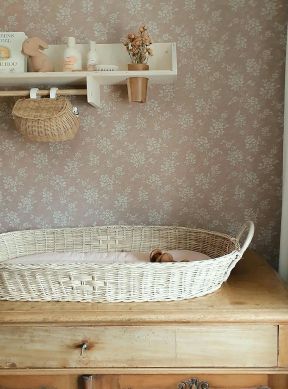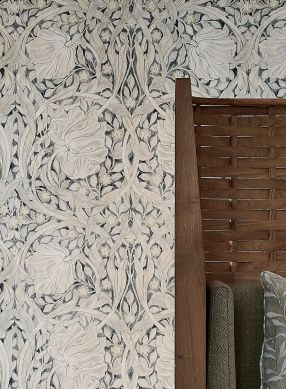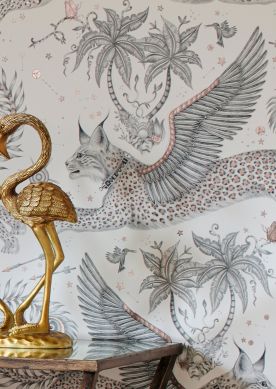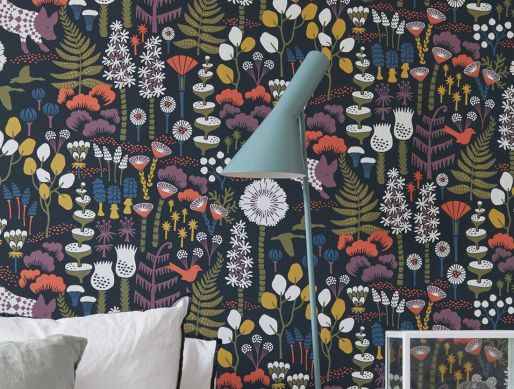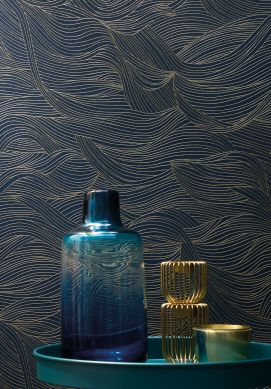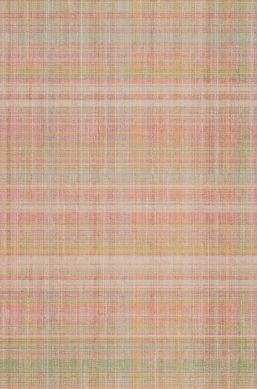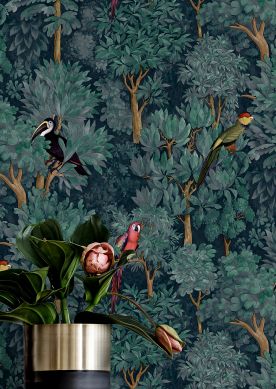Living room Wallpaper
Living Room Wallpaper - The Guide
Our living room is the place where we relax, where we entertain, and where we feel safe and comfortable. Wallpapers are a great way to give this space an individual touch. They can create a unique atmosphere of well-being. A stylish ambience and a representative character go hand in hand. The sky's the limit when it comes to style choices and creativity. Country House, Retro Lounge, Botanical, Modern Upper Class, Clean Chic, Romantic are just a few examples. In addition to personal preferences, other parameters like room size, layout, colour, etc. are also decisive factors when choosing the perfect wall décor. This guide answers the most important questions regarding living room wallpaper.
Table of Contents
- Lick of paint or wallpaper in the living room?
- What are the criteria for choosing the right wallpaper for the lounge?
- Which colour should I choose for the living room?
- Which types of wallpaper will make the living room appear more spacious?
- How much wallpaper should be used in living rooms?
- Where can I buy living room wallpapers?
- How much does it cost to have the living room wallpapered by a professional?
- Wallpaper ideas for living rooms
- Our tips: How to make a success of your wallpapering project
Lick of paint or wallpaper in the living room?
Whether it is preferable to simply paint the walls or use wallpaper to beautify your living room depends on aspects like practicality, functionality and comfort. A combination of wallpaper and paint is often the best option.
Painting living room walls - Pros and Cons
Pros
- For non-professionals, giving the walls a coat of paint is easier than putting wallpaper up.
- The costs for the paint is often more affordable than for wallpapers.
- Painted walls can be repainted repeatedly without the need for extensive preparation, and discolourations or dirt can easily be covered.
- Redecorating projects are easier.
Cons
- Depending on the underground (lining paper, primed walls, gypsum cardboard), more than one coat of paint might be necessary to ensure appropriate coverage.
- Required drying times have to be observed before the next coat can go on.
- It might take a few days until the room can be used again.
- Unpleasant paint smells.
- Matt paint can't be wiped clean with a wet cloth.
- Floors, kick plates, window frames, furniture need to be thoroughly covered to protect them from paint splatter.
Wallpapering living room walls - Pros and Cons
Pros
- A plethora of designs and surface finishes provides endless design options without a great deal of creative input.
- Wallpapers can create a huge number of atmospheres - from calm to invigorating - and appeal to the senses.
- Depending on material and thickness, wallpapers can have a sound-absorbing and heat-insulating effect, creating a sense of well-being.
- Non-woven and vinyl wallpapers cover minor unevenness and small cracks.
- The living room can be used almost immediately after wallpapering.
- There is also a large choice of washable, easy-care wallpapers.
Cons
- When it comes to wallpapering, manual dexterity and patience are important.
- The costs for the wallpaper is often higher than it would be for paint.
- Changing the interior design style usually involves the time-consuming effort of removing old wallpaper.
How to combine wallpaper with paint
Layout and size of the room are the main factors to consider when deciding whether walls painted in one colour should be combined with a pattern, motif, or effect wallpaper. Opulent, unusual and three-dimensional pattern wallpapers are all great choices for a feature wall. The remaining three walls can be painted in a matching or contrasting colour. Picking a specific colour of the wallpaper pattern for the painted walls is ideal as this will result in a unified picture.
Our service for you: Colour coding and non-woven wallpaper that can be painted over
You don't need to make a decision for or against any specific option. Why not combine them? We offer a special non-woven wallpaper (also known as lining paper) which creates the perfect surface for your painted walls and can be painted over at any point. Because we provide you with a colour code for every wallpaper, you can easily find the wall paint that will match your favourite design wallpaper.
What are the criteria for choosing the right wallpaper for the lounge?
Besides personal preferences, parameters like room size, architectural characteristics, light (natural/artificial), and ceiling height are all important factors to think about. Surface materials, cleaning characteristics, and how to hang the wallpaper are also significant considerations.
Room Size
A small living room will always benefit from light wallpaper colours and delicate, compact patterns with gentle movement. Darker and more intense wallpaper colours and larger-scale or three-dimensional patterns are great for more spacious rooms. Narrow, long spaces can appear bigger when wallpapers with horizontal stripes are used.
Special architectural characteristics/sloping ceilings
Rooms with bay windows, tricky corners, large recesses and alcoves, wall projections and ledges, a large number windows, or sloping ceilings require appropriate wallpapers. Complex pattern structures rarely lead to satisfying results. Instead, choose delicate patterns and designs, for instance stripes or floral elements, or paint those "tricky" areas.
Brightness/Light (artificial/natural)
The more natural light floods the room, the brighter it will appear. Combined with wallpapers in light colours, the room will visually increase in size and width. Dark wallpaper colours reduce potential glaring from strong daylight effects. For highly reflective or shiny wallpaper surfaces, the wall should be away from the direct line of view so that the eye isn't attracted as this would be distracting (for instance when watching TV).
Ceiling Height
High ceilings can appear lower when wallpapers with horizontal patterns are used. Another option is to choose two different wallpapers which "separate" the lower and upper part of the wall visually, making the ceiling appear lower. The oppressive character of a low ceiling can be balanced out by choosing a vertical pattern, especially stripes.
Surface Materials
Specific materials and surface characteristics lend haptic charm and interest to wallpaper. Textile and flock wallpapers with a tactile and authentic structure exude a cosy warmth. Glass bead wallpapers add sparkle and luxury to the room. Cork wallpapers fill the space with the purity of nature. With their iridescent sheen, metal wallpapers takes us on a journey to the future.
Hanging/removing wallpaper
Non-woven wallpapers are easy to put up - there are no waiting (soaking) times, as the wallpapering paste is applied directly to the wall. They can be pulled off the wall in a dry state - a quick and clean process that usually leaves no traces behind. For paper-based wallpapers, the adhesive is applied to the back and needs to soak in for a specific amount of time. Depending on the surface material, these types of wallpapers can be removed in a dry or damp state.
Washability
In family living rooms where children will be present, washable wallpapers with a sealed or coated surface (non-woven or vinyl wallpapers) are a great choice. Depending on their cleanability characteristics, they can be washable, super-washable or scrubbable. Spongeable wallpapers cannot be cleaned with damp cloths.
Which colour should I choose for the living room?
With the exception of colours that are too stimulating or bright (e.g. neon colours), anything is possible. Amongst the ultimate colour favourites for lounges and living rooms are white, beige, grey, blue, and green. Dark, muted shades of red or brown as well as black are also great options.
White
White symbolises purity, innocence, freshness. Wallpapers which are predominantly white are perfect for rooms which need an injection of light, width and space. In addition, white emphasises all other colours. Many elegant, modern, purist interior design concepts benefit greatly from white wallpapers. They are also ideally suited to the Scandinavian Look and Clean Chic.
Beige
This natural colour whose name is connected to lamb’s wool combines brown and white into a beautifully balanced (and balancing!) hue. It provides light, warmth and a sense of well-being. Beige pattern or base colours are popular in the Country House style but also add a certain je ne sais quoi to natural or Asia looks. Romantic or geometric wallpapers in beige have a fabulously light, almost weightless effect.
Grey
This mixture of white and black is the perfect partner for eccentric living room design experiments. The colour of neutrality and opposites comes in an almost endless array of nuances. Grey wallpaper can exude majestic elegance, delicate purity or voluptuous warmth. This is why they are true design wonders for modern, futuristic, atmospheric and bold styles.
Blue
The colour blue has a calming, balancing effect. It promotes creativity and innovation. Blue wallpapers offer a whole universe of ideas - from maritime to Mediterranean, from exotic to regal and glamorous. Darker shades of blue fill the room with enchanting magic, whilst green-blue and light blue hues are stimulating and open the mind.
Green
Green is synonymous with nature and spring, renewal and growth. In living rooms, green wallpapers promote relaxation whilst preventing tiredness. They are subtle sources of power, energy, and inspiration. Simply perfect for the botanical trend, nature look, tropical oases, coquettish romanticism, and flower power.
Which types of wallpaper will make the living room appear more spacious?
Wallpapers with delicate, soft patterns in light hues, with a subtle shimmer or shine, all make a small living room appear larger.
Patterns
Small rooms benefit from delicate, even, vertical pattern designs - especially when all walls are wallpapered. Lines, dots, floral or botanical elements are suitable examples. For those who prefer a more exuberant or darker pattern, a feature wall (without windows or doors) could be the best option. The remaining walls should be kept in light, friendly plain colours.
Wallpaper Colour
Light, natural and pastel wallpaper colours add space to a room. Light blue, cool turquoise, pea green, pastel violet, beige, grey, light wood shades, and marble white all possess this effect. White-gold and silver also make the room look larger. For long, narrow rooms, the long walls should be kept in light colours, the short ones in dark colours.
Shimmer and shine, metallic effects
Wallpapers with shimmering, metallic, or light-reflecting details create more space. For instance, a small room can become seemingly multi-dimensional by using a metal effect wallpaper. This type of wall décor can be applied to all walls or just on a feature wall - in some cases, involving the ceiling in the design concept can also work perfectly.
How much wallpaper should be used in living rooms?
Depending on the size, layout, and light conditions, the chosen wallpaper can be put up on all walls, a feature wall, three of the walls, two adjacent walls or two walls facing each other. Wallpapering the ceiling is also an increasingly popular option.
Feature Wall
Feature walls are a great option if a wallpaper model features a dominant, large-scale or multi-dimensional pattern. The remaining walls should be painted in matching colours. The wall behind the sofa or couch ensemble is particularly suited for a feature wall. After all, it shouldn't be hidden behind high or wide furniture. A very contemporary take on the concept is the "feature ceiling".
All-over wallpapering
To put the same wallpaper up on all four walls and perhaps even the ceiling does take a little bit of courage, but the results are often stunning. For a successful project of this nature, the pattern size, pattern run and colour combination of the wallpaper should work harmoniously with the size and light conditions of the room.
Three adjacent walls
In large rooms, three adjacent walls - bulkhead and side walls - can be adorned with the same design wallpaper. This creates a unified look which will be beautifully emphasised by one wall in just one single colour. It also allows for three-dimensional and large-scale patterns to be integrated more smoothly.
Two walls opposite each other or adjacent
Wallpapering two walls which face each other is a great option if, for example, two different but matching design wallpapers are to present their full effect. Adjacent walls with two different or the same pattern wallpaper can cleverly separate various different parts of the living room, e.g. dining area, reading space, play corner.
Where can I buy living room wallpapers?
Living room wallpapers can be purchased in specialist wallpaper shops, DIY stores, specialised on-line shops, or via the painter/decorator who is commissioned to do the work. The chosen avenue is down to personal priorities and preferences.
Specialist Wallpaper Shops
Specialist shops for painting and wallpapering products or interior design requirements provide a carefully selected product range as well as sample books by well-known manufacturers. Naturally, the selection will be somewhat limited. The greatest advantage is the availability of extensive advice by experts. If the desired wallpaper is in stock, it can be taken home immediately.
DIY Stores
Due to the comprehensive range of products for craftsmen and DIY enthusiasts, large DIY chains are divided into departments. The wallpaper departments will provide mainly the most common and popular models. Any advice available will be less extensive. The greatest advantages are that the wallpapers can be seen and touched right there and then and, if available in sufficient amounts, be taken home straight away.
On-line Wallpaper Shops
On-line shops specialising in wallpapers offer a multi-faceted range encompassing many exclusive wallpaper manufacturers and designers. There are usually many helpful features which will enable the consumer to make the right choice, and wallpaper calculators which will determine the exact amount required. To help with the decision-making, pattern samples can be ordered. The ordering process is streamlined and simple. There is also no need to travel or personally transport the purchased goods.
Painters/Decorators
If you commission a specialist to do the work for you, you will usually be able to source the wallpaper through them. However, the choice will be limited to those partners the company collaborates with. The smaller the company, the more limited the choices on offer. Painters/Decorators will be able to give you extensive advice.
How much does it cost to have the living room wallpapered by a professional?
Prices for wallpapering projects carried out by professionals are based on either square meters of wall space or living space. The final price depends on the type of wallpaper, level of complexity and preparation required. Material costs are also added. Costs can vary depending on regions, too.
Wallpaper Type
The cost for hanging the wallpaper depends on the type of wallpaper. Classic wood-chip wallpaper is the most cost-effective option; pattern wallpapers with rapport are more costly. Delicate surfaces, special gluing techniques and methods (e.g. for textile wallpapers) also add to the price per square meter.
Level of Complexity
Putting up wallpaper on ceilings, sloping ceilings, in bay windows, corners, ledges and other special architectural characteristics is particularly tricky and takes skill and patience, which results in additional costs per square meter.
Removing old wallpaper
Removing old wallpaper is charged separately. This process is easier and less time-consuming for non-woven wallpapers which can simply be pulled off in a dry state than for old paper-based wallpapers which will need soaking before scraping off.
Preparing the Surface
This is obviously much cheaper to do if there is just the odd crack or minor hole to fill rather than when a full-scale plastering job is required. Very absorbent walls need to be treated with deep primer or wallpapering paste before the actual wallpapering process can start. Applying a layer of lining paper will even out discolourations and minor cracks etc. of the surface. Each of these additional costs is calculated per square meter or hours required.
Special Processes
Amongst potential special processes which can push up prices significantly are the removal of distemper, full-scale plastering, or dealing with mould, all of which are calculated according to the effort and time involved.
Material Costs
Material costs include adhesive/wallpapering paste and other consumable materials like filler, putty, deep primer, lining paper. In addition, there is the cost for the wallpaper itself (if provided by the decorator).
Wallpaper ideas for living rooms
There is a plethora of styles and interior design options suitable for living rooms: Chilled Retro Lounge vibes, Colonial adventures, modern Baroque, Shabby Chic, Asia style, or Botanical oases are just a few themes that could be mentioned. Amongst the Top Five favourite styles are Country House, Modern Art, Classic, Scandinavian, and Luxury.
Country House Style
There is a variety of Country House styles, usually tied to specific regions: English Cottage, Country Estate "en Provence", Spanish Villa, Cottage in the Alps. The Country Look often features pastels and light, earthy, woody colours; depending on the specific sub-style, dark and strong hues might also feature. Great partners for this style are tile, stone and wood wallpapers, classic plaid designs, elegant stripe wallpapers, floral patterns with herbs and flowers, or models with playful animal motifs.
Modern
Modern wallpapers come in the most unconventional, unusual and provocative designs. They pick up on trends and reinterpret classic motifs - or create their own. Strong colours in striking combinations, fantastic effects and optical illusions are all components of contemporary lounge wallpapers. Modern Art demands attention, which means that the rest of the interior design concept should be kept simple and clean.
Classic Styles
Classic wallpaper patterns are timeless and yet very modern. With their striking composition of ornaments in a variety of sizes, wallpapers with Baroque motifs can be sophisticated, flamboyant or whimsical and hip. Wallpapers in the Art Deco style impress with stunning graphic elements, metal sheen effects and contemporary colour combinations. Art Nouveau wallpapers with artfully arranged ornaments create extravagant, sophisticated styles in living rooms.
Nordic/Scandinavian
The Scandi Style: Minimalist, refreshingly clean and extremely flexible. For this modern interior design look, wallpapers with graphic/geometric designs inspired by Swedish originals are the perfect match. White, light to medium shades of grey, ice-blue, beige and nude are the main basic colours. Furnishings feature straight lines, elements are reduced to the essentials - this is what makes the Scandinavian style so irresistible.
Luxury
Exotic leather, glamorous sparkly glass beads, shimmering gold and silver, iridescent metal, the finest silk, all combined with breath-taking pattern designs, structures and effects. The luxurious style of interior design is highly representative and exudes a sense of "only the best will do". Luxury is always extravagant, bold and not tied down to specific patterns.
Our tips: How to make a success of your wallpapering project
- Make use of our wallpaper pattern samples which will enable you to check and compare and make your decisions based on facts.
- Prepare a draft of your living room, including furniture and special room characteristics, colours of wall paint and wallpaper samples. This will give you a better idea of the end result.
- Bright colours or dominant patterns should be used sparingly as the lounge is, first and foremost, an area of relaxation, an oasis of calm. One feature wall with a patterned wallpaper is often enough to emphasise a specific style.
- An atmosphere of warmth and comfort can be created by choosing the right colours, material structures and wallpaper surfaces. Wallpapers with imitation wood designs, bamboo or cork finishes and textile wallpapers fill your lounge with a sense of comfort and well-being.






























